Smart Home Access Control Market Size
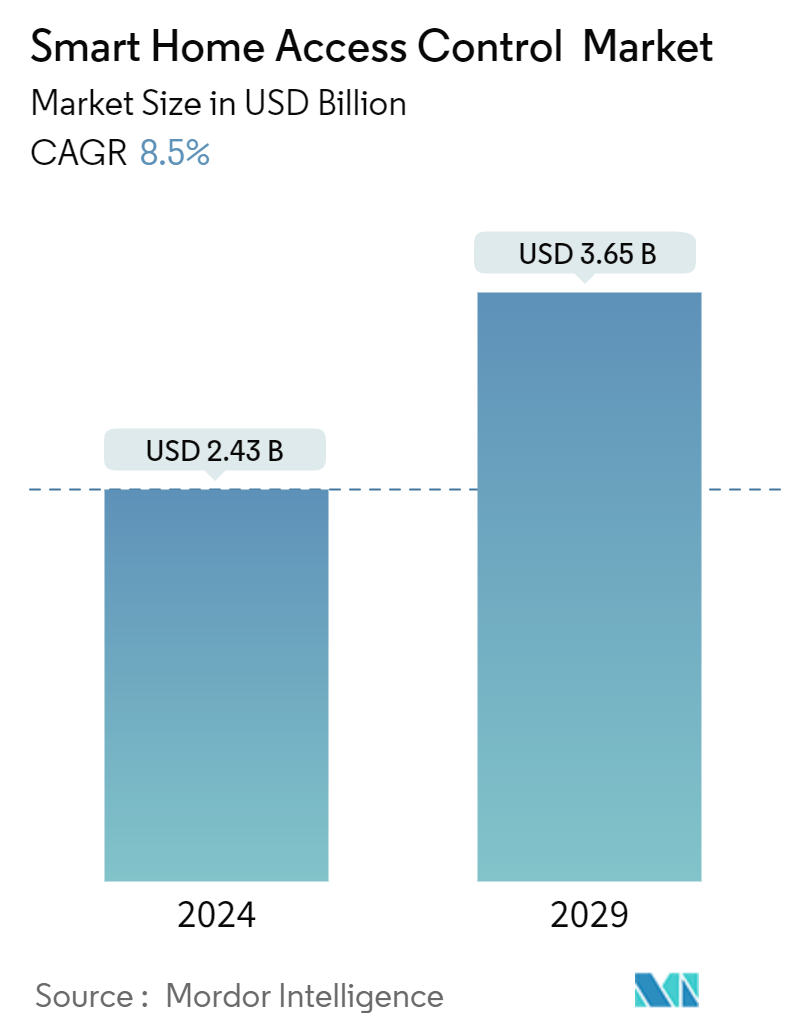
| Study Period | 2019 - 2029 |
| Market Size (2024) | USD 2.43 Billion |
| Market Size (2029) | USD 3.65 Billion |
| CAGR (2024 - 2029) | 8.50 % |
| Fastest Growing Market | Asia Pacific |
| Largest Market | North America |
Major Players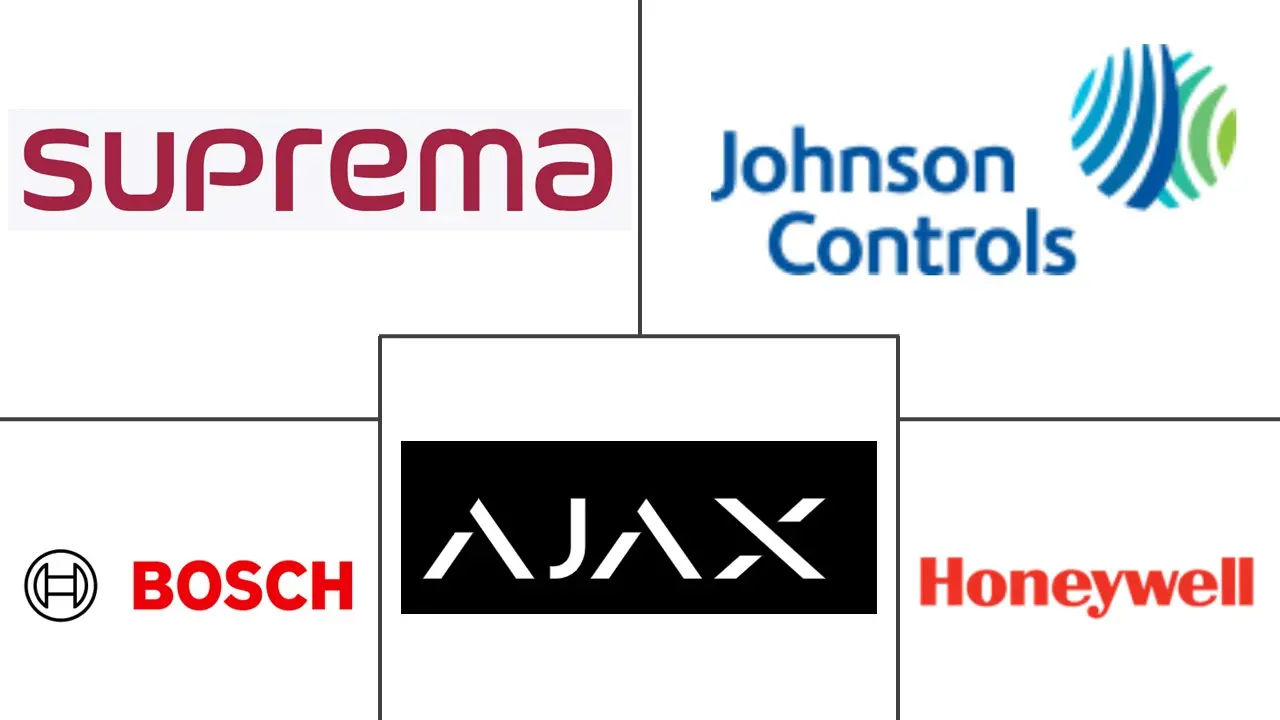
*Disclaimer: Major Players sorted in no particular order |
Smart Home Access Control Market Analysis
The Smart Home Access Control Market size is estimated at USD 2.43 billion in 2024, and is expected to reach USD 3.65 billion by 2029, growing at a CAGR of 8.5% during the forecast period (2024-2029).
While heavy steel doors and blaring alarms are often the focus of home security discussions, smart access control presents a more nuanced yet potent security solution. Utilizing entry codes, key fobs, and access cards, smart access control governs entries. Its key strength lies in its capacity to secure spaces and impact factors ranging from insurance coverage to mitigating accident losses.
Several factors are fueling the growth of the smart home access control market. These include heightened safety concerns due to rising burglary rates and the prevalence of nuclear families, especially in scenarios involving working parents and separated elderly relatives.
For homeowners, smart access control is pivotal in ensuring the privacy and security they deserve. Whether for communal areas, car parks, or personal flats, implementing barriers against unauthorized access enhances a property's appeal and provides valuable insights into building entries.
Moreover, the surge in tech-savvy populations and the rise of home automation projects bolstered the demand in the market.
While modern access control systems leverage cutting-edge technologies like biometrics, RF, Bluetooth, and NFC, end users are sometimes deterred by the associated testing, training, and implementation costs. Additionally, a lack of public awareness and operational hesitations, especially concerning the benefits of cloud-integrated wireless locks, pose hurdles to market expansion.
The global pandemic has significantly altered the landscape of smart home access control systems, emphasizing the monitoring of occupancy data to ensure safety. With both existing technologies and new additions introduced under the post-pandemic recovery agenda, the market is poised to unveil fresh opportunities in the future.
Smart Home Access Control Market Trends
The Biometric Readers Segment to Hold Major Market Share
- Biometric home security represents a modern shift in authentication methods, utilizing unique individual features for verification rather than traditional credentials. This technology is rapidly gaining traction in the home security sector. Homeowners increasingly use fingerprint, retina, or facial recognition technologies to bolster access control.
- Biometric locks elevate security measures, reducing reliance on conventional key-based systems. They are also crucial in multifactor verification, especially in high-security scenarios. For instance, after presenting a physical badge at a secure facility, a fingerprint can serve as an additional layer of verification.
- Statistically, burglary is often an opportunistic crime. While traditional key locks have long been vulnerable to such opportunists, smart locks, predominantly reliant on Bluetooth or Wi-Fi, introduce new vulnerabilities. Additionally, digital locks, hinging on PIN codes, are susceptible to hacking and prone to being forgotten.
- Considering these vulnerabilities, biometric readers are becoming popular for enhancing home security worldwide. Biometric sensors store data on the device, ensuring that power outages or unreliable Wi-Fi connections do not compromise the lock's security. This results in secure access to homes, cars, safes, and suitcases through smart locks, allowing only authorized users to gain entry.
- This heightened security is resonating with consumers. Recent research indicates that nearly one in three consumers express interest in adopting biometric readers for home access in the future. Beyond the security aspect, the convenience offered by biometric readers is further propelling the growth of this market.
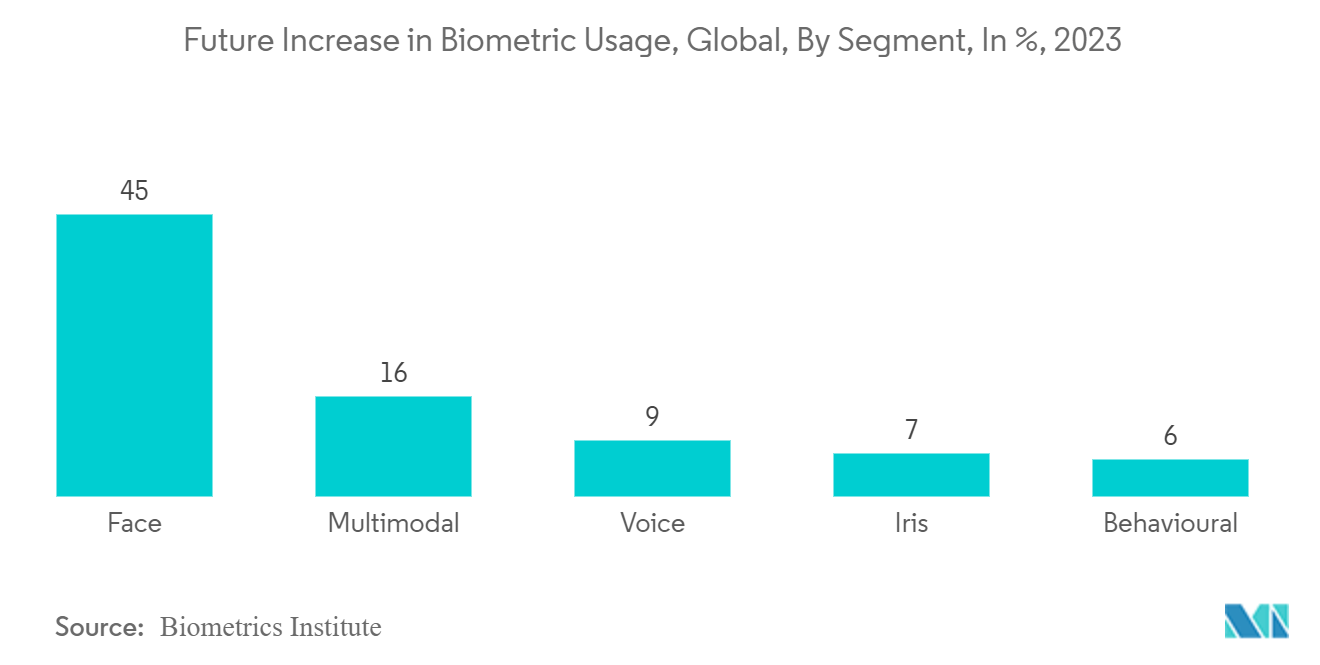
Asia-Pacific to Witness Significant Growth
- Asia is swiftly establishing itself as a dominant smart home access control market. Over the next five years, the region's growth trajectory hinges on the surging demand and adoption of technological advancements, particularly in home appliances and consumer electronics.
- Factors like the widespread adoption of smartphones, an expanding online business landscape, and robust government initiatives focused on digital transformation drive this momentum. According to the GSMA's 2023 report, "The Mobile Economy for Asia Pacific," several countries, including Australia, Japan, Singapore, and South Korea, have made 5G a mainstream technology.
- Notably, India is emerging as one of the fastest-growing 5G markets, with projections indicating the addition of tens of millions of 5G connections in 2023 alone. The region is poised to reach around 1.4 billion 5G connections by 2030, accounting for 41% of all mobile connections.
- Additionally, the region's robust economic growth has swelled the middle class, expanding the consumer base with increased purchasing power. As incomes rise across Asia, a larger consumer segment will move into higher income brackets. This shift within the consumer landscape is set to drive consumption, particularly in advanced technologies and services, further propelling the smart home access control market.
- Moreover, the region's escalating government investments in smart city initiatives are poised to unlock fresh opportunities. For instance, iToyota's ambitious 'Woven City' project, nearing completion, will serve as a testing ground for innovative urban living featuring driverless cars. 'Woven City' will be dotted with 'smart homes' embedded with sensors, enabling seamless communication among residents, buildings, and vehicles. With a primary focus on hydrogen power, the city aims to lead in emissions reduction and hydrogen-based technology.
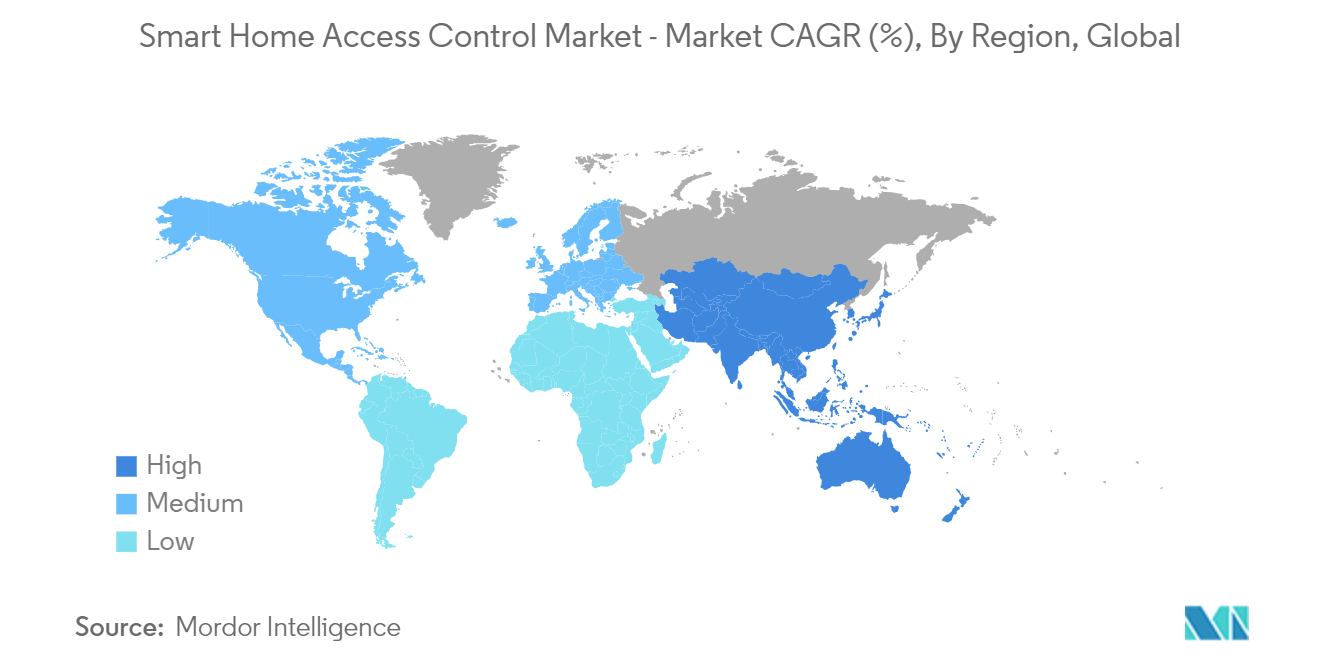
Smart Home Access Control Industry Overview
The smart home access control market is fragmented and comprises global and regional players striving for a larger share in a fiercely contested space. Despite the high barriers to entry, several new entrants have successfully made a mark in the market. Some of the notable players in the industry include Suprema Inc., Johnson Controls, Ajax Systems, Bosch Security System Inc., Honeywell International Inc., and others. Companies are making significant strategic decisions to increase their market presence.
April 2024: Resideo Technologies announced a USD 1.4 billion acquisition of a US smart home technology company. Resideo will merge Snap One into its ADI Global Distribution arm as part of the deal. This strategic move aims to bolster offerings for integrators, combining a wider array of third-party products with in-house solutions. The enhanced product lineup will be accessible through an expansive physical branch network complemented by robust digital tools.
September 2023: Guardian Access Solutions was acquired by CenterOak Partners, marking a transition into Guardian’s next phase of growth under CenterOak, which will support the company through continued investments in organic and inorganic growth initiatives as Guardian expands its leading presence in the access control industry throughout the Southeast and nationally.
Smart Home Access Control Market Leaders
-
Suprema Inc.
-
Bosch Security Systems
-
Ajax Systems
-
Honeywell International Inc.
-
Tyco International Plc (Johnson Controls
*Disclaimer: Major Players sorted in no particular order
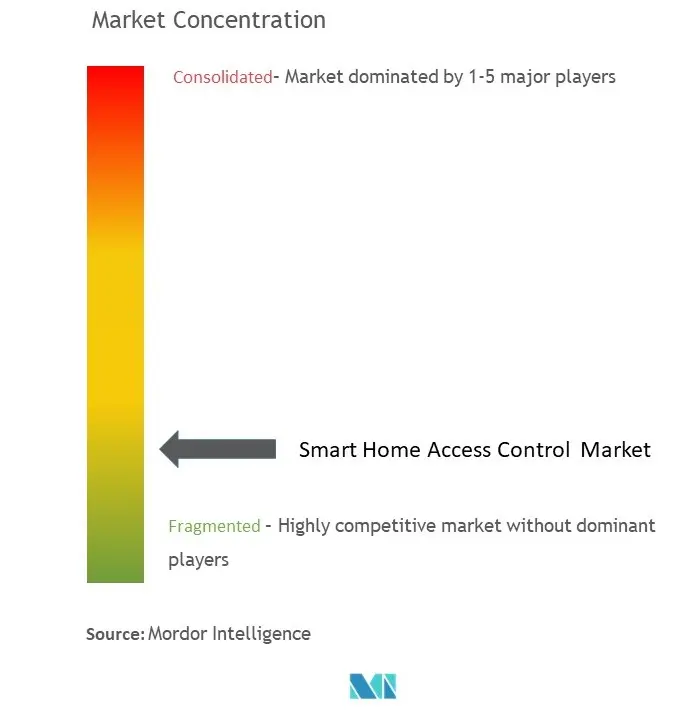
Smart Home Access Control Market News
- January 2024: Idlespace Technology unveiled the Philips Wi-Fi Palm Recognition Smart Deadbolt, a groundbreaking advancement in residential security. This innovative product promises heightened access control and convenience for consumers in the US. The deadbolt features cutting-edge grab-and-go technology, complete with built-in proximity sensors. These sensors detect people approaching the door and immediately send unlock signals to the deadbolt.
- May 2023: Akuvox launched an all-new smart access control series, including access control terminals A01, A02, A03, and A05, and a door controller A092 for residential and commercial markets. The Akuvox access control series can work with a broad range of external systems, such as elevator, time-attendance systems, telephony systems, and video management systems, based on open-platform technology.
Smart Home Access Control Market Report - Table of Contents
1. INTRODUCTION
- 1.1 Study Assumptions and Market Definition
- 1.2 Scope of the Study
2. RESEARCH METHODOLOGY
3. EXECUTIVE SUMMARY
4. MARKET INSIGHTS
- 4.1 Market Overview
-
4.2 Industry Attractiveness - Porter's Five Forces Analysis
- 4.2.1 Bargaining Power of Suppliers
- 4.2.2 Bargaining Power of Consumers
- 4.2.3 Threat of New Entrants
- 4.2.4 Threat of Substitute Products
- 4.2.5 Intensity of Competitive Rivalry
- 4.3 Industry Value Chain Analysis
- 4.4 Impact of Macro Economic Trends on the Market
5. MARKET DYNAMICS
-
5.1 Market Drivers
- 5.1.1 Growing Adoption of Access Control Systems Owing to Rising Crime Rates and Threats
- 5.1.2 Technological Advancements
-
5.2 Market Restraints
- 5.2.1 Operational and ROI Concerns
-
5.3 Technology Snapshot
- 5.3.1 Evolution of Access Control Solutions
- 5.3.2 Comparitive Analysis of RFID and NFC Technology
- 5.3.3 Key Technological Trends
6. MARKET SEGMENTATION
-
6.1 By Type
- 6.1.1 Card Reader and Access Control Devices
- 6.1.1.1 Card-based
- 6.1.1.2 Proximity
- 6.1.1.3 Smart Card (Contact and Contactless)
- 6.1.2 Biometric Readers
- 6.1.3 Electronic Locks
- 6.1.4 Software
- 6.1.5 Other Types
-
6.2 By Geography***
- 6.2.1 North America
- 6.2.1.1 United States
- 6.2.1.2 Canada
- 6.2.2 Europe
- 6.2.2.1 United Kingdom
- 6.2.2.2 Germany
- 6.2.2.3 France
- 6.2.3 Asia
- 6.2.3.1 China
- 6.2.3.2 Japan
- 6.2.3.3 India
- 6.2.3.4 South Korea
- 6.2.4 Australia and New Zealand
- 6.2.5 Latin America
- 6.2.6 Middle East and Africa
7. COMPETITIVE LANDSCAPE
-
7.1 Company Profiles*
- 7.1.1 Suprema Inc.
- 7.1.2 Tyco International PLC (Johnson Controls
- 7.1.3 Bosch Security Systems
- 7.1.4 Ajax Systems
- 7.1.5 Honeywell International Inc.
- 7.1.6 Nedap NV
- 7.1.7 Thales Group (Gemalto NV)
- 7.1.8 Allegion PLC
- 7.1.9 ASSA ABLOY AB Group
- 7.1.10 Schneider Electric SE
- 7.1.11 Panasonic Corporation
- 7.1.12 Brivo Systems LLC
- 7.1.13 Identiv Inc.
- 7.1.14 Dormakaba Holding AG
- 7.1.15 NEC Corporation
- 7.1.16 Idemia Group
- 7.1.17 Axis Communication AB
8. INVESTMENT ANALYSIS
9. FUTURE OF THE MARKET
** Subject To AvailablitySmart Home Access Control Industry Segmentation
A smart home access control system is an intelligent system that involves new technologies such as electronics, communication technology, and computer technology. It is a measure to solve security issues and manage entry and exit points. Moreover, it ensures resources within the home can be accessed only by authorized users, even restricts legitimate users, and prevents unauthorized users.
The smart home access control market is segmented by type (card reader and access control devices [card-based, proximity, and smart card (contact and contactless)], biometric readers, electronic locks, software, and other types) and geography (North America [United States and Canada], Europe [United Kingdom, Germany, France, and Rest of Europe], Asia-Pacific [China, India, Japan, South Korea, and Rest of Asia-Pacific], and Rest of the World). The market sizes and forecasts are provided in terms of value (USD) for all the segments.
| By Type | Card Reader and Access Control Devices | Card-based |
| Proximity | ||
| Smart Card (Contact and Contactless) | ||
| By Type | Biometric Readers | |
| Electronic Locks | ||
| Software | ||
| Other Types | ||
| By Geography*** | North America | United States |
| Canada | ||
| By Geography*** | Europe | United Kingdom |
| Germany | ||
| France | ||
| By Geography*** | Asia | China |
| Japan | ||
| India | ||
| South Korea | ||
| By Geography*** | Australia and New Zealand | |
| Latin America | ||
| Middle East and Africa |
Smart Home Access Control Market Research FAQs
How big is the Smart Home Access Control Market?
The Smart Home Access Control Market size is expected to reach USD 2.43 billion in 2024 and grow at a CAGR of 8.5% to reach USD 3.65 billion by 2029.
What is the current Smart Home Access Control Market size?
In 2024, the Smart Home Access Control Market size is expected to reach USD 2.43 billion.
Who are the key players in Smart Home Access Control Market?
Suprema Inc., Bosch Security Systems, Ajax Systems, Honeywell International Inc. and Tyco International Plc (Johnson Controls are the major companies operating in the Smart Home Access Control Market.
Which is the fastest growing region in Smart Home Access Control Market?
Asia Pacific is estimated to grow at the highest CAGR over the forecast period (2024-2029).
Which region has the biggest share in Smart Home Access Control Market?
In 2024, the North America accounts for the largest market share in Smart Home Access Control Market.
What years does this Smart Home Access Control Market cover, and what was the market size in 2023?
In 2023, the Smart Home Access Control Market size was estimated at USD 2.22 billion. The report covers the Smart Home Access Control Market historical market size for years: 2019, 2020, 2021, 2022 and 2023. The report also forecasts the Smart Home Access Control Market size for years: 2024, 2025, 2026, 2027, 2028 and 2029.
Smart Home Access Control Industry Report
Statistics for the 2024 Smart Home Access Control market share, size and revenue growth rate, created by Mordor Intelligence™ Industry Reports. Smart Home Access Control analysis includes a market forecast outlook for 2024 to 2029 and historical overview. Get a sample of this industry analysis as a free report PDF download.



